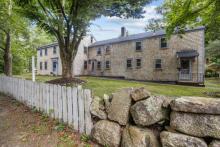Blacksmith discusses colonial-era Wareham
The Wareham Historical Society hosted a presentation from Dean Rantz, a blacksmith from Middleborough, at the Methodist Meeting House on Main Street Monday night.
Rantz spoke about colonial era blacksmithing, Wareham blacksmiths from that time, and displayed two tables full of his own work, everything from swords and axes to door hinges and candle holders.
"Every small town in colonial America needed a blacksmith," Rantz said. "He was the hardware store, the auto mechanic, anything to do with metal all rolled into one."
Rantz got his start at the Massachusetts College of Art where he graduated with a BFA in sculpture and art history in 1982. He explained that in colonial times someone would become an apprentice as early as the age of seven, then work their way up to a journeyman by the time they were 21.
If he was good enough and able to find a town with a blacksmith vacancy he could open his own shop and officially become a master.
Rantz said all the cranberry bogs in Wareham were likely iron bogs in the 1700s and people would be able to mine out iron that naturally developed there.
He also said one of the most important products of colonial blacksmiths, especially in Wareham, were nails.
"They were hard to get because they had to be made one at a time," Rantz said. He added, "supposedly they would burn down buildings just to get the nails."
The Tremont Nail Factory in Wareham, which dates back to 1819, signified a technological advancement in the production of nails.
He said looking at nails is one method to date buildings, which is something he is occasionally asked to do by restoration groups.
Rantz went on to describe the blacksmith's role in making products for cooking, shipping, and the general day-to-day lives of the people in his community.
"The blacksmith was probably more important that a doctor at that time," Rantz said. "He was the craftsman's craftsman."















